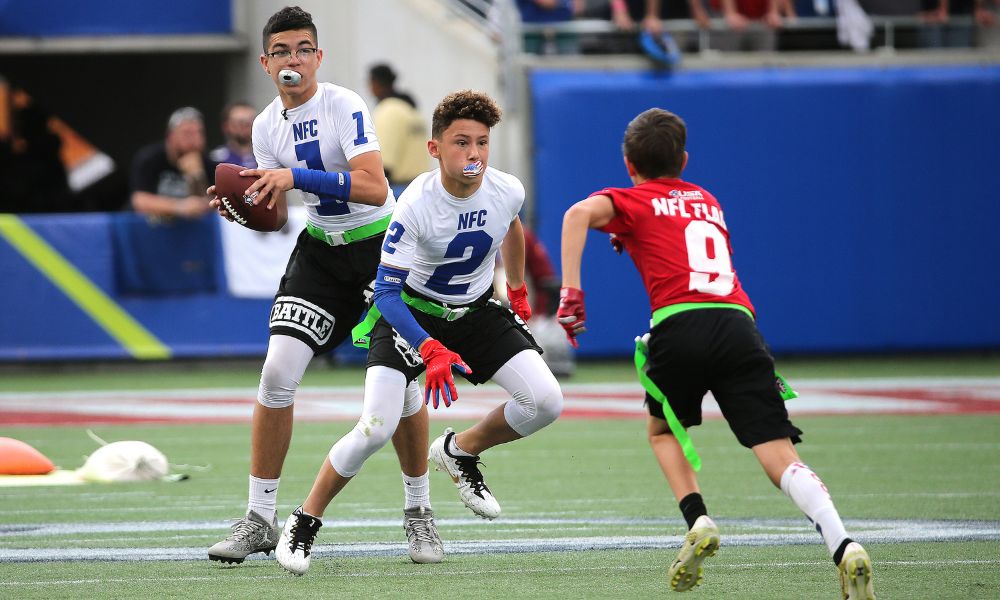Getty Images
Quick quiz: What is the only major US professional team sport that has never featured on the official program of the Olympic Games?
Answer: football.
That could be about to change.
Flag football, a fast-growing version of America’s most popular sport, is making a convincing case for inclusion in the Los Angeles 2028 Games.
It’s a dynamic, free-flowing, young-generation sport that includes men’s and women’s competitions and is growing around the world – with reports suggesting it is now played in more than 100 countries.
The International Federation of American Football (IFAF), the world governing body for the sport, is leading flag’s proposal for Olympic inclusion with heavyweight support from the National Football League (NFL).
As a lifelong American football fan, this writer sees flag as a perfect fit for the LA Games: an all-action, youth-oriented, gender-balanced, low-cost sport featuring on the world stage with Olympic gold medals at stake.
Besides the prospect of being a big hit with fans and broadcasters alike, flag football presents the International Olympic Committee (IOC) and Los Angeles organisers with a unique opportunity: linking up with America’s number one sport in the most lucrative commercial market – the United States.
Flag football would appear to fit the IOC’s Olympic Agenda 2020+5 strategy: youth appeal, gender balance, social media friendly, small squads, inexpensive, a flexible format that can be played at different sites.
One could imagine flag football bringing the same high-octane energy to the Olympics as 3×3 basketball, which made its debut at the Tokyo 2020 Games. Both sports feature quick-fire scoring and short games. Both can be played at iconic local venues.
EVP of Football Operations @TroyVincentSr speaks to why flag football should be added as an Olympic sport for the 2028 LA games.
— NFL (@NFL) October 14, 2022
The NFL’s commitment to the sport will be on full display next month when the annual Pro Bowl game will be transformed into a flag football format at Allegiant Stadium in Las Vegas on 5th February.
Meanwhile, American football’s growth overseas continues unabated.
London has hosted regular season NFL games every year since 2007, including three this season. A crowd of 86,215 – the largest attendance in the history of NFL international games – watched the Denver Broncos beat the Jacksonville Jaguars 21-17 at Wembley Stadium on 30th October. More than 60,000 spectators attended each of the two previous games in London this season at Tottenham Hotspur Stadium.
In the first ever regular-season NFL game in Germany, a raucous capacity crowd of 69,811 fans watched Tom Brady’s Tampa Bay Buccaneers hold off the Seattle Seahawks 21-16 on 13th November at the Allianz Arena, home of Bayern Munich.
Germany will also stage NFL games over at least the next four seasons, including in Frankfurt. Cities in Spain and France could also be targeted as future NFL hosts.
And, in the fifth regular season game played in Mexico City, an exuberant crowd of 78,427 fans watched the San Francisco 49ers beat the Arizona Cardinals on 21st November at Estadio Azteca.
While the international reach and appeal of American football is stronger than ever, the league has identified flag football as its new long-term global priority.
‘Flag is the future of football,’ Troy Vincent, the NFL’s executive vice president of football operations, wrote in a recent op-ed.
‘It’s happening in front of our eyes – flag football is already played in more than 100 countries and counting,’ Vincent added. ‘The momentum is real. Countries such as Mexico and Canada are flush with talent.’
It’s worth looking at the numbers promoted by the sport: 2.4 million kids under 17 playing organised flag football in the US, with global participation close to 20 million. Campaigners say the fastest growth is among girls and women, with about 15,700 girls playing in high schools in the US, a 40 per cent increase over three years.
For the uninitiated, there are crucial differences between flag football and tackle football.
Flag football does not involve huge men in helmets and pads crashing into each other with bone-crushing force. This is a non-contact sport in which players wear tightly fitted belts with yellow flags on either side of their hips. They are “tackled” when the defensive player pulls off the flag. The sport prioritises speed and agility over size and strength.
Flag football is played by boys and girls and features men’s and women’s teams at senior levels. The game is played with five players on each side. There are no goal posts and no kicking or punting. Flag football is played on a field of 70 yards by 30 yards. Games are played over two halves of 20 minutes. The action is fast-paced, passing-dominated and high-scoring.
In short, flag football seems natural for the modern type of low-cost, easily accessible Olympic competition.
Flag football was a big hit at The World Games in Birmingham, Alabama, in July 2022. Mexico won gold in the women’s competition, with the United States taking silver and Panama bronze. The US defeated Italy in the men’s final, with Mexico earning bronze.
The NFL’s role in backing Olympic flag football could be a game-changer for the IOC and LA.
Imagine the IOC and NFL joining forces to promote the Olympic Games in the US, the world’s most valuable sports market. They already have a common broadcast partner in NBC and share commercial sponsors, including Procter & Gamble and Visa. The NFL could use its array of commercial and digital assets to help support the Games in 2028 and beyond. It would be a partnership of powerful sports organisations with huge benefits for both sides.

Flag football is played by boys and girls and features men’s and women’s teams at senior levels
So what will it take for flag football to make it into the Games?
The IOC gives local organisers the chance to propose “additional sports” for their editions of the Games, with local popularity among the key factors.
Flag is one of nine sports under consideration by LA, along with baseball-softball, breakdancing, cricket, karate, kickboxing, lacrosse, motorsports and squash.
All nine made recent presentations to LA organisers, who are expected to make proposals to the IOC in the coming months. A final decision will be made at the IOC Session in September 2023.
Ultimately, it may come down to a numbers game. There are currently 28 sports on the LA programme. Boxing, weightlifting and modern pentathlon were left off the initial list by the IOC amid various governance and ethics concerns. The IOC has said they could be brought back if they meet certain requirements.
If any of the three are reinstated, fewer additional spots will be open. If they remain left out, opportunities increase.
Baseball and softball, which were dropped for the 2012 and 2016 Games, brought back for 2020 and omitted again for 2024, will make a strong pitch. Cricket, with a huge market in India, is making a hard push to join the Games. Breakdancing, which will make its debut in Paris, has obvious youth appeal.
How many sports will be put forward or approved for LA remains uncertain.
Given the evolving Olympic landscape, don’t underestimate flag football. The sport could take people by surprise. It ticks all the boxes. The timing is right. The location is right. It makes sense – for athletes, fans, the IOC and Los Angeles.
When Los Angeles hosted its first Games in 1932, American football was a demonstration sport, featuring a single game between two teams of college players.
Now, nearly a century later, and with the Games returning to LA, football – flag football – could make its debut as a full Olympic medal sport.
Steve Wilson is the former European sports editor and Olympics correspondent for The Associated Press. He has covered 16 Summer and Winter Olympic Games.

